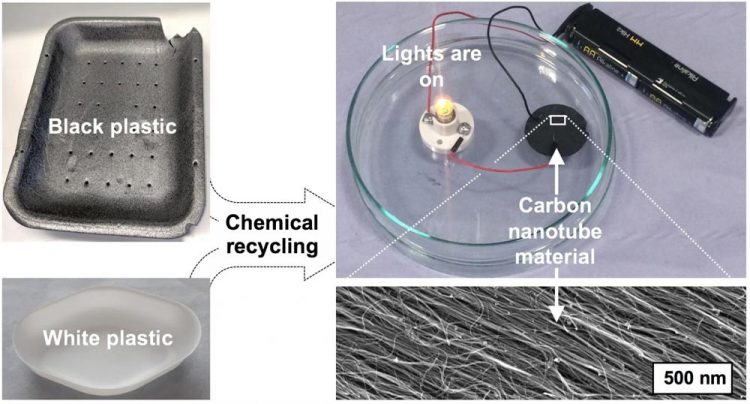Research shows black plastics could create renewable energy

The process by which plastics are converted to carbon nanotube material. Credit: Dr Alvin Orbaek White
Research from Swansea University has found how plastics commonly found in food packaging can be recycled to create new materials like wires for electricity – and could help to reduce the amount of plastic waste in the future.
While a small proportion of the hundreds of types of plastics can be recycled by conventional technology, researchers found that there are other things that can be done to reuse plastics after they've served their original purpose.
The research, published in The Journal for Carbon Research, focuses on chemical recycling which uses the constituent elements of the plastic to make new materials.
While all plastics are made of carbon, hydrogen and sometimes oxygen, the amounts and arrangements of these three elements make each plastic unique. As plastics are very pure and highly refined chemicals, they can be broken down into these elements and then bonded in different arrangements to make high value materials such as carbon nanotubes.
Dr Alvin Orbaek White, a Sêr Cymru II Fellow at the Energy Safety Research Institute (ESRI) at Swansea University said: “Carbon nanotubes are tiny molecules with incredible physical properties.
The structure of a carbon nanotube looks a piece of chicken wire wrapped into a cylinder and when carbon is arranged like this it can conduct both heat and electricity. These two different forms of energy are each very important to control and use in the right quantities, depending on your needs.
“Nanotubes can be used to make a huge range of things, such as conductive films for touchscreen displays, flexible electronics fabrics that create energy, antennas for 5G networks while NASA has used them to prevent electric shocks on the Juno spacecraft.”
During the study, the research team tested plastics, in particular black plastics, which are commonly used as packaging for ready meals and fruit and vegetables in supermarkets, but can't be easily recycled. They removed the carbon and then constructed nanotube molecules from the bottom up using the carbon atoms and used the nanotubes to transmit electricity to a light bulb in a small demonstrator model.
Now the research team plan to make high purity carbon electrical cables using waste plastic materials and to improve the nanotube material's electrical performance and increase the output, so they are ready for large-scale deployment in the next three years.
Dr Orbaek White said: “The research is significant as carbon nanotubes can be used to solve the problem of electricity cables overheating and failing, which is responsible for about 8% of electricity is lost in transmission and distribution globally.
“This may not seem like much, but it is low because electricity cables are short, which means that power stations have to be close to the location where electricity is used, otherwise the energy is lost in transmission.
“Many long range cables, which are made of metals, can't operate at full capacity because they would overheat and melt. This presents a real problem for a renewable energy future using wind or solar, because the best sites are far from where people live.”
Media Contact
All latest news from the category: Materials Sciences
Materials management deals with the research, development, manufacturing and processing of raw and industrial materials. Key aspects here are biological and medical issues, which play an increasingly important role in this field.
innovations-report offers in-depth articles related to the development and application of materials and the structure and properties of new materials.
Newest articles

First-of-its-kind study uses remote sensing to monitor plastic debris in rivers and lakes
Remote sensing creates a cost-effective solution to monitoring plastic pollution. A first-of-its-kind study from researchers at the University of Minnesota Twin Cities shows how remote sensing can help monitor and…

Laser-based artificial neuron mimics nerve cell functions at lightning speed
With a processing speed a billion times faster than nature, chip-based laser neuron could help advance AI tasks such as pattern recognition and sequence prediction. Researchers have developed a laser-based…

Optimising the processing of plastic waste
Just one look in the yellow bin reveals a colourful jumble of different types of plastic. However, the purer and more uniform plastic waste is, the easier it is to…



